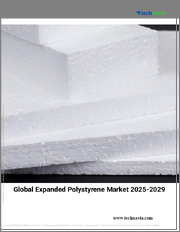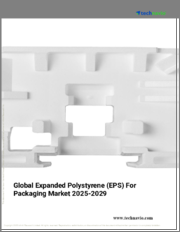
|
시장보고서
상품코드
1521090
세계의 발포 폴리스티렌(EPS) 시장 : 예측(2024-2029년)Expanded Polystyrene (EPS) Market - Forecasts from 2024 to 2029 |
||||||
발포 폴리스티렌(EPS) 시장은 예측 기간 동안 연평균 3.38% 성장하여 2024년 63억 8,900만 달러에서 2029년 75억 4,400만 달러에 이를 것으로 예상됩니다.
발포 폴리스티렌(EPS) 시장은 예측 기간 동안 큰 성장을 보일 것으로 예상됩니다. 아시아태평양은 포장 및 건설 분야의 강력한 수요로 인해 주요 시장이 될 것으로 예상됩니다. 이 시장의 성장과 관련된 새로운 요인으로는 다음과 같은 것들이 있습니다. 세계 인구 증가와 라이프스타일의 변화로 인해 '친환경' 제품이나 '공정무역' 컨셉과 같은 고품질, 고부가가치 제품에 대한 수요가 증가하고 있습니다. 그러나 제품 가용성 및 환경적 제약으로 인해 시장 성장이 계속 둔화되고 있습니다. 그러나 이러한 요인에도 불구하고, 바이오 폴리스티렌에 대한 수요 증가와 EPS의 새로운 용도의 출현으로 시장 성장이 예상되고 있습니다. 이 시장의 성장을 가속하는 다른 요인들도 있습니다.
도시 인구는 발포 폴리스티렌(EPS) 시장 성장에 큰 기여를 하고 있습니다. 도시화가 진행됨에 따라 포장재와 단열재를 최대한 효율적으로 사용하는 것이 최우선 과제가 되고 있으며, 테라플라스트의 EPS 제품은 우수한 단열성과 환경 친화적인 특성으로 이러한 요구를 충족시키기에 이상적입니다. 또한, 전자, 자동차 등 다양한 분야의 기술 개발로 인해 고품질 포장재에 대한 수요가 증가하고 있습니다. 이미 확대되고 있는 전자상거래 추세는 전기자동차의 인기 증가로 보완되어 EPS 수요를 촉진하고 있습니다. 따라서 EPS 시장은 이 두 부문의 지원으로 지속적인 성장을 이룰 가능성이 높습니다.
EPS 시장은 또한 친환경 포장재와 건축자재에 대한 세계 인구 수요 증가로 인해 성장하고 있습니다. 전 세계 사람들이 환경 보호에 대한 인식이 높아지면서 친환경 제품을 선호하고 있습니다. 따라서 EPS는 밀도가 낮고, 환경 친화적인 기업에게 이점이 있어 포장재로 선호되고 있습니다. 건축에서 EPS는 단열재로도 사용되며, 경제성이 뛰어납니다. 또한, 에너지 효율과 친환경 실천에 대한 인식이 EPS 사용을 촉진하는 요인으로 작용하고 있으며, 점점 더 많은 정부가 EPA의 시행과 지원, EPS 폐기물을 줄이기 위한 대책을 내놓고 있어 EPS 시장은 이러한 대책으로 이익을 얻을 것으로 예상됩니다.
이머징 마켓 수요도 EPS 시장의 인기에 일조하는 또 다른 요인입니다. 최근 빠르게 성장하고 있는 지역으로는 인구가 도시화되고 경제가 빠른 속도로 성장하고 있는 중국과 인도가 있으며, 포장재와 건축자재에 대한 수요가 증가하고 있습니다. 이들 국가의 성장 요인인 중산층 증가는 현재 포장된 상품, 나아가 EPS를 요구하고 있습니다. 또한, 이들 국가에서 빠르게 도입되고 있는 지원 인프라는 특히 건설 프로젝트에서 EPS의 더 큰 시장을 창출하고 있습니다. 또한, 일부 신흥 시장도 서서히, 그러나 꾸준히 성장하고 있으며, 시장 수요 증가에 따라 EPS 시장도 확대될 수 있는 기회를 얻고 있습니다.
발포 폴리스티렌(EPS) 시장 성장 촉진요인:
- 유형별로는 화이트 EPS 부문이 예측 기간 동안 가장 빠르게 성장할 것임.
백색 EPS 부문은 예측 기간 동안 발포 폴리스티렌(EPS) 시장에서 가장 빠르게 성장하는 제품 유형이 될 것으로 예상됩니다. 이러한 성장은 포장 분야에서 사용되는 백색 EPS에 대한 시장 수요가 지속적으로 증가하고 있기 때문입니다. 백색 EPS는 가장 일반적인 EPS 유형으로 대부분의 건설업체들이 선호하고 있습니다. 또한 백색 EPS는 다재다능하고 다양한 분야에 적용될 수 있기 때문에 향후 인기가 높아질 것으로 예상됩니다. 포장과 관련하여 백색 EPS는 다양한 소비재, 전자제품, 식품의 보호 및 단열 제품 제조에 많이 사용되고 있습니다. 이 부문을 주도하는 요인으로는 온라인 쇼핑의 확대, 경량화, 고강도 및 내구성을 갖춘 더 나은 포장에 대한 요구가 있습니다. 또한, 외식 산업이 확대되면서 화이트 EPS로 구성된 트레이와 컵과 같이 적절하고 지속 가능한 포장에 대한 요구가 증가하고 있는 것도 이 부문의 성장에 박차를 가하고 있습니다. 포장 용도 외에도 화이트 EPS는 보온성으로 인해 벽체 단열재, 지붕 및 기초 깔개 등 건축자재로도 사용되고 있습니다. 에너지 절약 건물을 도입하기 위한 정부의 이니셔티브와 전 세계적으로 개선된 에너지 규범과 규제의 통합 및 혁신 등 건설 산업의 성장은 화이트 EPS의 사용을 촉진하는 요인으로 작용할 것으로 예상됩니다. 또한, 가구, 스포츠 용품, 자동차에 사용되는 화이트 EPS의 사용도 이 부문의 성장을 가속하고 있습니다.
- 유형별로는 그레이/실버 EPS 부문이 시장 성장을 주도
그레이/실버 EPS 부문이 유형별 발포 폴리스티렌(EPS) 시장 성장을 견인할 것으로 예상되며, EPS 시장은 유형별로 향후 높은 성장률을 보일 것으로 예상되는 발포 폴리스티렌(EPS)의 그레이/실버로 구분됩니다. 특히 그레이 EPS는 단열성이 뛰어나기 때문에 비용을 고려하면 다른 제품보다 높은 성장세를 보일 것으로 예측됩니다. 난연제, 흑연 및 기타 첨가제는 경쟁이 심화되고 있는 '개질' EPS라는 새로운 분야에 도입되고 있습니다. 지속 가능한 포장의 중요성 증가, 에너지 효율 및 "친환경" 건축의 촉진 등 "친환경" 제품 및 솔루션에 대한 사회적 선호의 변화는 회색 및 은색 EPS에 대한 세계 수요를 지속적으로 촉진하고 있습니다. 뿐만 아니라, 특히 전자통신 분야에서의 보호 포장재 사용 증가와 건축 분야에서 가볍고 내구성이 뛰어난 단열재에 대한 수요도 이 부문의 성장을 보완하고 있습니다. 그 결과, 회색 및 은색 EPS 부문은 전 세계적으로 사용되는 산업 증가를 보완하고 해당 시장에서 EPS의 주요 견인차 역할을 할 것으로 예상됩니다.
- 건축 및 건설 산업에서 발포 폴리스티렌(EPS) 사용 확대
건축 및 건설 산업에서 발포 폴리스티렌(EPS)의 사용 확대는 EPS 시장 확대의 주요 촉진요인입니다. 또한 여러 저자들은 건축 및 건설 분야에서 발포 폴리스티렌(EPS)의 사용 증가에 대해 언급했습니다. 특히 건설 및 건축 산업이 현대에서 가장 빠르게 성장하는 산업 중 하나라는 사실을 고려할 때, 다양한 목적으로 EPS의 사용이 빠르게 증가하고 있습니다. 건설 산업에서 EPS는 독특하고 독특한 단열 능력, 경량성 및 다재다능함으로 인해 널리 보급되었습니다. 건설 산업에서 EPS는 특히 벽과 지붕의 단열재로 널리 사용되어 기초를 가볍게 지탱하는 데 사용됩니다. 닫힌 다공성과 낮은 열전도율 덕분에 EPS 단열재는 건축물의 에너지 절약을 위한 최적의 솔루션으로 여겨져 왔으며, EPS 단열재는 냉난방 관리를 개선하고 건설 부문의 배출량 감소에 대한 증가하는 요구 사항을 충족시킵니다.
또한, EPS는 긴 수명, 흰개미 및 화학물질에 대한 불활성, 쉬운 시공 등의 특성으로 인해 건설 시장에서 높은 평가를 받고 있으며, EPS의 단열 성능과 배향성 스트랜드 보드 및 기타 면재의 구조적 성능을 결합한 구조용 단열 패널(SIP)의 건설에도 사용되고 있습니다. 사용되고 있습니다. 이러한 SIP는 열적 및 구조적 능력을 보조하기 위해 주택 및 소규모 상업용 건물 건설에 더 많이 사용되고 있습니다.
지속 가능한 건설 활동, 에너지 사용, 비용 효율적이고 내구성이 뛰어난 건축자재 배출은 EPS가 건설 분야에서 인기를 얻고 있는 이유 중 하나입니다. 전 세계적으로 건설 산업이 발전함에 따라 EPS 응용 분야는 발포 폴리스티렌(EPS) 시장 성장에 대한 수요를 유지할 것으로 예상됩니다.
예측 기간 동안 아시아태평양이 발포 폴리스티렌(EPS) 시장을 장악할 것으로 예상됩니다.
중국, 일본, 인도, 한국 등 주요 경제 국가들이 아시아태평양을 지배하고 있습니다. 가장 빠르게 성장하는 신흥국 중 일부는 아세안 국가 등 이 지역의 국가들입니다. 인도와 중국은 세계 인구의 약 35.5%를 차지합니다. 아시아태평양은 친환경 소재에 대한 수요를 촉진하는 중요한 생산 능력을 구성하는 위의 여러 국가의 본거지이기 때문에 예측 기간 동안 발포 폴리스티렌(EPS) 시장을 독점할 것으로 예상됩니다.
아시아태평양은 인구 증가, 도시화, 인프라 개발, 제조업 증가로 인해 발포 폴리스티렌(EPS) 시장을 주도할 것으로 예상됩니다. 중국, 인도 등 신흥국의 전자상거래 시장의 급격한 성장은 제품 보호를 위한 경량 포장재에 대한 수요를 증가시켜 EPS의 소비율을 높일 것으로 예상됩니다. 또한, APAC의 지속적인 경제 발전과 유리한 정부 정책은 EPS 산업의 높은 시장 점유율과 성장에 기여하고 있습니다.
이 지역의 활발한 산업 및 건설 산업은 단열재, 포장 및 응용 분야에서 EPS에 대한 높은 수요를 뒷받침하고 있습니다. 이 지역에서는 지속가능한 포장재와 건축자재에 대한 수요가 높으며, 가볍고 재활용이 가능하고 비용 효율성이 높은 EPS가 이에 적합합니다. 또한, 중국, 일본, 한국 등 아시아태평양의 선진국은 에너지 절약과 친환경 건축에 대한 관심이 높아지면서 건축용 및 단열재로서 EPS에 대한 수요가 증가하고 있습니다. 이 지역의 인구 밀도가 빠르게 증가하고 있으며, 이에 따라 주거 및 상업 지역에 대한 수요가 증가하고 있습니다. 전반적으로 아시아태평양의 경제 발전, 인구, EPS 시장의 인프라 개발 등의 요인은 EPS 시장의 성장에 유리하게 작용하고 있으며, 그 결과 아시아태평양이 세계 우위를 점하고 있습니다.
목차
제1장 서론
- 시장 개요
- 시장의 정의
- 조사 범위
- 시장 세분화
- 통화
- 전제조건
- 기준년과 예측년 타임라인
- 이해관계자에게 있어서의 주요 이점
제2장 조사 방법
- 조사 디자인
- 조사 과정
제3장 주요 요약
- 주요 조사 결과
- 애널리스트의 견해
제4장 시장 역학
- 시장 성장 촉진요인
- 시장 성장 억제요인
- Porter의 Five Forces 분석
- 업계 밸류체인 분석
제5장 발포 폴리스티렌(EPS) 시장 : 제품 유형별
- 서론
- 화이트 EPS
- 그레이/실버 EPS
제6장 발포 폴리스티렌(EPS) 시장 : 최종사용자 산업별
- 서론
- 건축 및 건설
- 전기 및 전자
- 포장
- 기타
제7장 발포 폴리스티렌(EPS) 시장 : 지역별
- 세계 개요
- 북미
- 미국
- 캐나다
- 멕시코
- 남미
- 브라질
- 아르헨티나
- 기타 남미
- 유럽
- 영국
- 독일
- 프랑스
- 이탈리아
- 스페인
- 기타 유럽
- 중동 및 아프리카
- 사우디아라비아
- 아랍에미리트(UAE)
- 기타 중동 및 아프리카
- 아시아태평양
- 중국
- 인도
- 일본
- 한국
- 대만
- 태국
- 인도네시아
- 기타 아시아태평양
제8장 경쟁 환경과 분석
- 주요 기업과 전략 분석
- 시장 점유율 분석
- 합병, 인수, 합의 및 협업
- 경쟁 대시보드
제9장 기업 개요
- Atlas Roofing Corporation
- Alpek SAB de CV
- BASF SE
- BEWI
- Epsilyte LLC
- Kaneka Corporation
- Ravago Petrokimya Uretim AS
- SABIC
- SUNPOR
- Synthos
- Unipol Holland BV
- Versalis SpA
- Wuxi Xingda Foam Plastic New Material Limited
- Loyal Group
The expanded polystyrene (EPS) market is expected to grow at a CAGR of 3.38% over the forecast period to reach a market size of US$7.544 billion in 2029, increasing from estimated value of US$6.389 billion in 2024.
The Expanded polystyrene (EPS) market is expected to experience significant growth over the forecast period. Asia-Pacific is expected to be the key market, benefiting from booming demand in the packaging and construction segments. Some of the emerging factors being associated with the growth of this market include. An ever-growing global population and changing lifestyles are dictating the need for high quality and added value items like 'green' goods and the concepts of 'fair trade' A swiftly expanding application of the EPS in the marine floatation and floating decks. However, limitations such as high availability of products and environmental constraints continue to slow the growth of the market. However, amid these factors, the market is anticipated to grow owing to the rising necessity for bio-based polystyrene and emerging applications of EPS. There are other factors also which are fuelling the growth in this market.
The city population is collectively providing a tremendous contribution towards the market growth of Expanded polystyrene (EPS). With the development of the scale of urbanization, the primary task remains to use packaging and insulating materials as efficiently as possible. Theraplast's EPS product has good thermal insulation attributes, and it can also be considered environmentally friendly, which makes it ideal for meeting such requirements. Also, the technological development of various segments like electronics, automotive, and others has resulted in a higher demand for quality packaging materials. The already growing trend of e-commerce is complemented by the growing popularity of electric vehicles which also fuels the demand for EPS. Therefore, the market for EPS is likely to experience a sustained level of growth due to the support it receives from these two sectors.
The EPS market is also fundamental on the back of the increasing needs of the global population in environmentally friendly packaging and building materials. People around the world are developing a consciousness of environmental conservation and would prefer goods that are ecologically friendly. EPS is thus preferred for packaging due to its low density and the benefits it has for environment-conscious businesses. In construction, the EPS is also used for insulation, and it is also economical. This means that Awareness of energy efficiency and green practices is also a factor that is promoting the use of EPS. Since more governments are putting in place measures to conduct or support EPA and reduce waste on this material, the EPS market is anticipated to gain from these measures.
The need from emerging markets also constitutes one more factor that is playing a part in the popularity of the EPS market. Some of the areas that have grown rapidly over the recent past include China and India where the population is urbanized, and the economies are growing at a fast pace, thus giving rise to the demand for packaging and construction materials. This growth in the middle class which is a factor of growth in these countries is now demanding packaged goods and consequently EPS. Also, supportive infrastructure that is rapidly being adopted in these countries has created a greater market for EPS, especially in construction projects. There are also emerging markets that are slowly but steadily expanding and, therefore, with the increased market demand, the EPS market will have the opportunity to expand as well.
EXPANDED POLYSTYRENE MARKET DRIVERS:
- The white EPS segment by type is likely to be the fastest-growing type during the forecast period.
The white EPS segment is expected to be the fastest-growing product type in the expanded polystyrene (EPS) market during the forecast period. This kind of growth has been brought about by the ever-growing market demand for white EPS for use in the packaging sector. White EPS is the most popular type of EPS and it is preferred by most builders. White EPS is also expected to gain popularity in the future due to its general-purpose nature and its applicability in different fields. When it comes to packaging, white EPS is heavily utilized for the production of protective as well as insulating products for various consumers' goods, electronics, and foods. Some of the driving factors that have been attributed to this segment include: One of the major drivers for the need for white EPS in this segment is the growth in online shopping and the need for more superior packaging that is lightweight and has high strength and durability. Further, the escalating food service industry and need for the appropriate and sustainable packaging including trays and cups constituted from white EPS is also adding up to the segment. Aside from its use in packaging, white EPS is also used as construction material in structures for wall insulation and padding of roofs and foundations because of its thermal capability of EPS. The growth in the construction industry including the focus of governments to incorporate energy-efficient buildings and the integration of and innovation of improved energy codes and regulations around the world are factors that are predicted to motivate the use of white EPS. Besides, the sales having white EPS along with furniture, sports equipment, and automotive are boosting the segment's growth as well.
- The Grey and Silver EPS segment by type is likely to drive the growth of the market
The grey and silver EPS segment is expected to drive the growth of the Expanded polystyrene (EPS) market by type. Based on the type, the EPS market has been segmented as grey and silver which is likely to show high growth rates for Expanded polystyrene in the future. Specifically, it has been forecasted that grey EPS will experience higher growth than other products because of its excellent thermal insulating properties, more so when cost is taken into consideration. Flame retardants, graphite, and other additives have been brought into the new segment of 'modified' EPS where competition has increased. The switches in society's preferences towards 'green' products and solutions, inclusive of a growing importance on sustainable packaging and the promotion of energy efficiency and 'green' building have continued to foster the global demand for grey and silver EPS. Not only this, the increasing use of protective packaging materials especially in the e-communication sector, and the demand for lightweight and durable insulating material in construction aspects also supplement the growth of this segment. Consequently, the grey and silver EPS segment can be projected as a major EPS driving force in its market, complementing the industries' increased use throughout the globe.
- The growing application of Expanded polystyrene in the building and construction industry
The growing application of Expanded polystyrene (EPS) in the building and construction industry is a key driver of the EPS market's expansion. Several authors have also commented on the increasing use of Expanded polystyrenes in the building and construction sector. The use of EPS for various purposes is increasing rapidly, especially in light of the fact that the construction and building industry is one of the most rapidly growing industries of the current era. EPS in the construction industry has come to prevail for its unique and unique ability to insulate, lightweight, and versatility. In construction, EPS applies widely, especially in walls and roof insulation, and provides lightweight support for the foundations. Thanks to its shut-porosity and low thermal conductivity it has been considered as an optimal solution for saving the energies in the constructions. EPS insulation improves heating and cooling management hence meeting the increasing demands for emissions reduction in the construction sector.
Moreover, characteristics such as the material's longevity, the inertness to termites and chemicals, and simple installation have reinforced the material's reputation in the construction market. EPS is also used in the construction of Structural Insulated panels (SIPs) that involve the insulation capability of the EPS and the structural capability of oriented strand boards or other facing materials. These SIPs are increasingly being used in constructing homes and small commercial structures since they aid in thermal and structural capacities.
The emission of sustainable construction activities, energy utilization, and cost-effective and more durable construction materials are among the reasons that have seen EPS gaining popularity in construction. With the advancement in the construction industry on the global level the EPS application is predicted to sustain its demand in the market growth of Expanded polystyrene.
Asia-Pacific region to dominate the Expanded polystyrene market during the forecast period.
The major economies like China, Japan, India, and South Korea dominate the Asia-Pacific region. Some of the fastest-growing emerging economies are from this region such as ASEAN countries. India and China have about 35.5% of the world's population. The Asia Pacific region is expected to dominate the expanded polystyrene market during the forecast period owing to the region being the home of several countries as mentioned above constituting significant production capacities that are driving the demand for eco-friendly materials.
The Asia Pacific has been identified as to lead in the Expanded polystyrene (EPS) market resulting from population growth, rising urbanization, infrastructural developments, and increasing manufacturing industries. The exponential growth of e-commerce markets in developing countries such as China and India is projected to raise the demand for lighter packaging aids that offer protection to products which, in turn, boosts the consumption rate of EPS. Furthermore, the constant economic development and the favorable government policies in the APAC contributed to a high market share and growth of the EPS industry.
Intense industrial and construction industries in the region are likely to support high EPS demand in markets such as insulation, packaging, and uses. There is a large demand in this region for sustainable packaging and construction material, which EPS is a good fit for as it is lightweight, recyclable, and cost-efficient. In addition, energy conservation and green building implementation in developed countries in the Asia-Pacific such as China, Japan, and South Korea are boosting EPS for construction usage and insulating materials. The population density is rapidly increasing throughout the region, and it is accompanied by the need for more housing and commercial area which in turn leads to a higher production demand for EPS usage for construction and packaging purposes. Altogether, factors such as the Asia-Pacific region's economic progress, population, and infrastructure development for the EPS market align in favor of its growth, resulting in its global dominance.
The Expanded polystyrene market is segmented and analyzed as follows:
By Product Type
- White EPS
- Grey and Silver EPS
By End-User Industry
- Building and Construction
- Electrical and Electronics
- Packaging
- Others
By Geography
- North America
- USA
- Canada
- Mexico
- South America
- Brazil
- Argentina
- Others
- Europe
- United Kingdom
- Germany
- France
- Italy
- Spain
- Rest of Europe
- Middle East and Africa
- Saudi Arabia
- Saudi Arabia
- United Arab Emirates
- Rest of Middle East and Africa
- Asia-Pacific
- China
- India
- Japan
- South Korea
- Taiwan
- Thailand
- Indonesia
- Rest of Asia-Pacific
TABLE OF CONTENTS
1. INTRODUCTION
- 1.1. Market Overview
- 1.2. Market Definition
- 1.3. Scope of the Study
- 1.4. Market Segmentation
- 1.5. Currency
- 1.6. Assumptions
- 1.7. Base and Forecast Years Timeline
- 1.8. Key benefits for the stakeholders
2. RESEARCH METHODOLOGY
- 2.1. Research Design
- 2.2. Research Process
3. EXECUTIVE SUMMARY
- 3.1. Key Findings
- 3.2. Analyst View
4. MARKET DYNAMICS
- 4.1. Market Drivers
- 4.1.1. Increasing Demand from the Building and Construction Industry
- 4.1.2. Rising Demand from the Packaging Industry
- 4.2. Market Restraints
- 4.2.1. Environmental Regulations
- 4.2.2. Alternative Products for EPS
- 4.3. Porter's Five Forces Analysis
- 4.3.1. Bargaining Power of Suppliers
- 4.3.2. Bargaining Power of Buyers
- 4.3.3. The Threat of New Entrants
- 4.3.4. Threat of Substitutes
- 4.3.5. Competitive Rivalry in the Industry
- 4.4. Industry Value Chain Analysis
5. EXPANDED POLYSTYRENE MARKET BY PRODUCT TYPE
- 5.1. Introduction
- 5.2. White EPS
- 5.3. Grey and Silver EPS
6. EXPANDED POLYSTYRENE MARKET BY END-USER INDUSTRY
- 6.1. Introduction
- 6.2. Building and Construction
- 6.3. Electrical and Electronics
- 6.4. Packaging
- 6.5. Others
7. EXPANDED POLYSTYRENE MARKET BY GEOGRAPHY
- 7.1. Global Overview
- 7.2. North America
- 7.2.1. United States
- 7.2.2. Canada
- 7.2.3. Mexico
- 7.3. South America
- 7.3.1. Brazil
- 7.3.2. Argentina
- 7.3.3. Rest of South America
- 7.4. Europe
- 7.4.1. United Kingdom
- 7.4.2. Germany
- 7.4.3. France
- 7.4.4. Italy
- 7.4.5. Spain
- 7.4.6. Rest of Europe
- 7.5. Middle East and Africa
- 7.5.1. Saudi Arabia
- 7.5.2. United Arab Emirates
- 7.5.3. Rest of Middle East and Africa
- 7.6. Asia-Pacific
- 7.6.1. China
- 7.6.2. India
- 7.6.3. Japan
- 7.6.4. South Korea
- 7.6.5. Taiwan
- 7.6.6. Thailand
- 7.6.7. Indonesia
- 7.6.8. Rest of Asia-Pacific
8. COMPETITIVE ENVIRONMENT AND ANALYSIS
- 8.1. Major Players and Strategy Analysis
- 8.2. Market Share Analysis
- 8.3. Mergers, Acquisitions, Agreements, and Collaborations
- 8.4. Competitive Dashboard
9. COMPANY PROFILES
- 9.1. Atlas Roofing Corporation
- 9.2. Alpek SAB de CV
- 9.3. BASF SE
- 9.4. BEWI
- 9.5. Epsilyte LLC
- 9.6. Kaneka Corporation
- 9.7. Ravago Petrokimya Uretim AS
- 9.8. SABIC
- 9.9. SUNPOR
- 9.10. Synthos
- 9.11. Unipol Holland BV
- 9.12. Versalis SpA
- 9.13. Wuxi Xingda Foam Plastic New Material Limited
- 9.14. Loyal Group



















